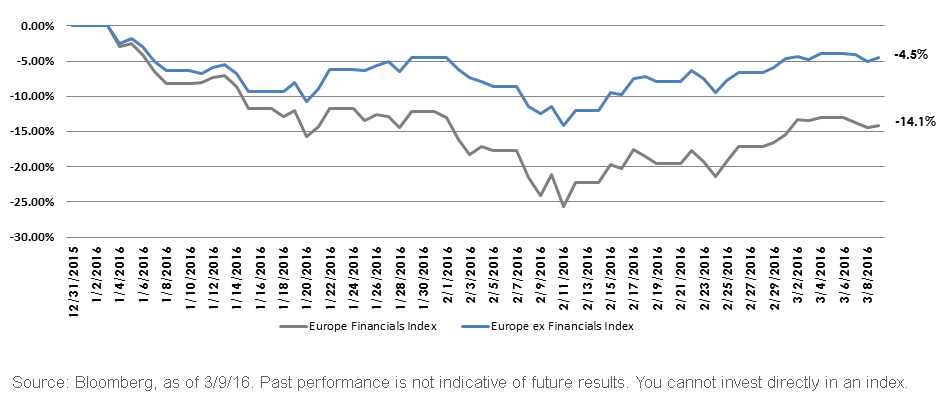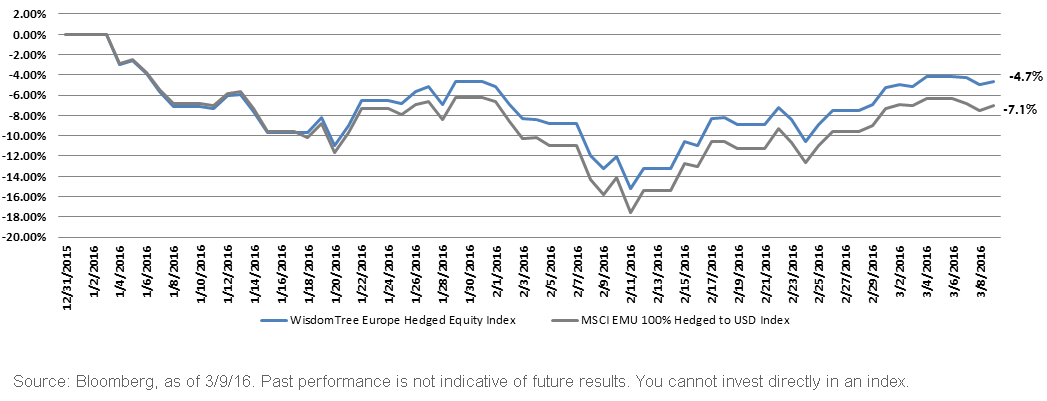Across the U.S., Europe, Japan and emerging markets, Financials have been the weakest-performing sector so far this year. On March 10, 2016, Mario Draghi and the European Central Bank (ECB) announced a fresh round of measures to help stimulate the European economy: a cut to -0.40% for deposits held at the ECB; a reduction to 0% for the main refinancing operations rate; an increase of €20 billion per month of
quantitative easing (QE); a broadening of bond eligibility to now include
investment-grade, non-financial
corporate debt; and a new series of four targeted longer-term refinancing operations (TLTRO II).
While the impact of these policies on specific segments of the economy will likely be uneven, European Financials have led the way lower, falling by nearly 25% year to date before rebounding.
1 In this piece, we focus on the challenges facing European banks and introduce some tools we believe may help investors navigate uncertainty in the current market environment.
Regulatory Reform
Throughout history, banks have operated within the uncomfortable intersection of
monetary policy, politics and the real economy. While this complicated balancing act will likely not change anytime soon, European regulators have taken a variety of approaches in an effort to bring reform to the banking system. Increased authority and oversight, enhanced capital adequacy requirements and a desire by shareholders for banks to simplify their operations have led to an arguably more stable financial system.
Unfortunately, while many of these programs may represent steps in the right direction, banking (particularly in Europe) remains extremely complex. Additionally, while efforts have been made to apply a singular set of rules and standards, a large degree of variation exists among banks of different sizes and geographies. Therefore, during times of market stress, the worst is assumed until rumors can be thoroughly disproven. To start 2016, new “
bail-in” provisions have been put into effect in the eurozone. Under these measures, private sector creditors will be forced to absorb losses during bank failures before government funds are made available. While these policies may serve as an important step in limiting “too big to fail,” some questions remain about their operations during periods of crisis.
Half-Empty vs. Half-Full
While the European Central Bank (ECB) has been among the most
aggressive adopters of unconventional monetary policy, it remains dependent on member banks to transmit its
stimulus efforts to the real economy. On one hand, access to
credit via loans to
small and medium-sized enterprises (SMEs), the backbone of business in Europe, has increased while borrowing costs have declined. The volume of new bank loans of less than €250,000 rose to €32 billion, up 16% year over year.
2 However, with a less-developed securitization market in Europe, concerns about the impact of legacy
nonperforming loans on bank capital adequacy ratios have given some investors pause. In response, many analysts wonder if banks will be able to consistently earn in excess of their cost of equity.
Complicating matters further, these concerns are not limited to small, regional players on the periphery. Given the propensity for large banks to originate loans across the monetary union (often at higher rates), mega-cap financials like Deutsche Bank, UniCredit and BNP Paribas have seen borrowing costs climb as equity markets fell in recent weeks.
3 While regulators appear confident in public that the recovery remains on track, the uncertainty is clearly causing some investors to derisk their portfolios and ask questions later.
Financials vs. Nonfinancials
MSCI Europe ex Financials Index vs. MSCI Europe Financials Index
 For definitions of indexes in the chart, visit our glossary.
For definitions of indexes in the chart, visit our glossary.
Since the beginning of the year, financial stocks in Europe have underperformed nonfinancial stocks by 10 percentage points. While some may view the relative weakness of bank stocks as a buying opportunity, others may be looking for ways to reduce exposure to European banks while maintaining exposure to European or developed world equities.
Two Ways to Lighten Up on European Financials
Many investors may know that the
WisdomTree Europe Hedged Equity Fund’s (HEDJ) underlying Index, the
WisdomTree Europe Hedged Equity Index, which requires that companies derive at least 50% of their revenue outside of Europe, tilts its constituents toward European exporters. But by doing so, the rules-based Index typically under-weights the Financials sector compared to traditional
cap-weighted “
beta” exposure to eurozone stocks. As of March 10, 2016, this WisdomTree Index was under-weight European Financials by 12 percentage points, while over-weighting companies in the Consumer Staples, Industrials and Consumer Discretionary sectors.
4 This is one of the reasons why, for the first ten weeks of 2016, the WisdomTree Europe Hedged Equity Index outperformed the
MSCI EMU 100% Hedged to USD Index, which has a 21% weight in European Financials.
5
Year-to-Date Returns
WisdomTree Europe Hedged Equity Index vs. MSCI EMU 100% Hedged to USD Index
 For definitions of indexes in the chart, visit our glossary.
International Applications
For definitions of indexes in the chart, visit our glossary.
International Applications
For investors looking for a way to eliminate exposure to financial stocks in the developed world outside the U.S., WisdomTree has also created the
WisdomTree International Dividend ex-Financials Index. This index strategy is designed to provide exposure to high-yielding stocks outside the Financials sector in the developed world outside the United States. Learn more about the
WisdomTree International Dividend ex-Financials Fund (DOO), which track this Index.
1Source: Bloomberg, as of 3/10/16.
2Source: ECB, 12/16.
3Source: Bloomberg, as of 2/15/16.
4Source: WisdomTree, as of 3/10/16.
5Sources: MSCI, Bloomberg, as of 3/9/16.
Important Risks Related to this Article
There are risks associated with investing, including possible loss of principal. Foreign investing involves special risks, such as risk of loss from currency fluctuation or political or economic uncertainty. Funds focusing their investments on certain sectors may be more vulnerable to any single economic or regulatory development. This may result in greater share price volatility.
Investments in currency involve additional special risks, such as credit risk and interest rate fluctuations. Derivative investments can be volatile, and these investments may be less liquid than other securities, and more sensitive to the effects of varied economic conditions. As HEDJ can have a high concentration in some issuers, the Fund can be adversely impacted by changes affecting those issuers. Due to the investment strategy of this Fund, it may make higher capital gain distributions than other ETFs. Please read each Fund’s prospectus for specific details regarding each Fund’s risk profile.


 For definitions of indexes in the chart, visit our glossary.
Since the beginning of the year, financial stocks in Europe have underperformed nonfinancial stocks by 10 percentage points. While some may view the relative weakness of bank stocks as a buying opportunity, others may be looking for ways to reduce exposure to European banks while maintaining exposure to European or developed world equities.
Two Ways to Lighten Up on European Financials
Many investors may know that the WisdomTree Europe Hedged Equity Fund’s (HEDJ) underlying Index, the WisdomTree Europe Hedged Equity Index, which requires that companies derive at least 50% of their revenue outside of Europe, tilts its constituents toward European exporters. But by doing so, the rules-based Index typically under-weights the Financials sector compared to traditional cap-weighted “beta” exposure to eurozone stocks. As of March 10, 2016, this WisdomTree Index was under-weight European Financials by 12 percentage points, while over-weighting companies in the Consumer Staples, Industrials and Consumer Discretionary sectors.4 This is one of the reasons why, for the first ten weeks of 2016, the WisdomTree Europe Hedged Equity Index outperformed the MSCI EMU 100% Hedged to USD Index, which has a 21% weight in European Financials.5
Year-to-Date Returns
WisdomTree Europe Hedged Equity Index vs. MSCI EMU 100% Hedged to USD Index
For definitions of indexes in the chart, visit our glossary.
Since the beginning of the year, financial stocks in Europe have underperformed nonfinancial stocks by 10 percentage points. While some may view the relative weakness of bank stocks as a buying opportunity, others may be looking for ways to reduce exposure to European banks while maintaining exposure to European or developed world equities.
Two Ways to Lighten Up on European Financials
Many investors may know that the WisdomTree Europe Hedged Equity Fund’s (HEDJ) underlying Index, the WisdomTree Europe Hedged Equity Index, which requires that companies derive at least 50% of their revenue outside of Europe, tilts its constituents toward European exporters. But by doing so, the rules-based Index typically under-weights the Financials sector compared to traditional cap-weighted “beta” exposure to eurozone stocks. As of March 10, 2016, this WisdomTree Index was under-weight European Financials by 12 percentage points, while over-weighting companies in the Consumer Staples, Industrials and Consumer Discretionary sectors.4 This is one of the reasons why, for the first ten weeks of 2016, the WisdomTree Europe Hedged Equity Index outperformed the MSCI EMU 100% Hedged to USD Index, which has a 21% weight in European Financials.5
Year-to-Date Returns
WisdomTree Europe Hedged Equity Index vs. MSCI EMU 100% Hedged to USD Index
 For definitions of indexes in the chart, visit our glossary.
International Applications
For investors looking for a way to eliminate exposure to financial stocks in the developed world outside the U.S., WisdomTree has also created the WisdomTree International Dividend ex-Financials Index. This index strategy is designed to provide exposure to high-yielding stocks outside the Financials sector in the developed world outside the United States. Learn more about the WisdomTree International Dividend ex-Financials Fund (DOO), which track this Index.
1Source: Bloomberg, as of 3/10/16.
2Source: ECB, 12/16.
3Source: Bloomberg, as of 2/15/16.
4Source: WisdomTree, as of 3/10/16.
5Sources: MSCI, Bloomberg, as of 3/9/16.
For definitions of indexes in the chart, visit our glossary.
International Applications
For investors looking for a way to eliminate exposure to financial stocks in the developed world outside the U.S., WisdomTree has also created the WisdomTree International Dividend ex-Financials Index. This index strategy is designed to provide exposure to high-yielding stocks outside the Financials sector in the developed world outside the United States. Learn more about the WisdomTree International Dividend ex-Financials Fund (DOO), which track this Index.
1Source: Bloomberg, as of 3/10/16.
2Source: ECB, 12/16.
3Source: Bloomberg, as of 2/15/16.
4Source: WisdomTree, as of 3/10/16.
5Sources: MSCI, Bloomberg, as of 3/9/16.


